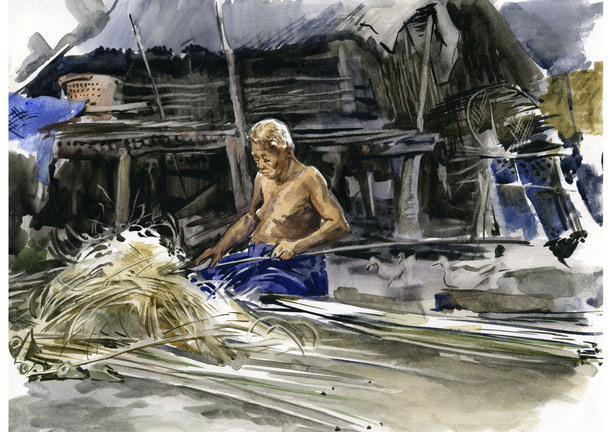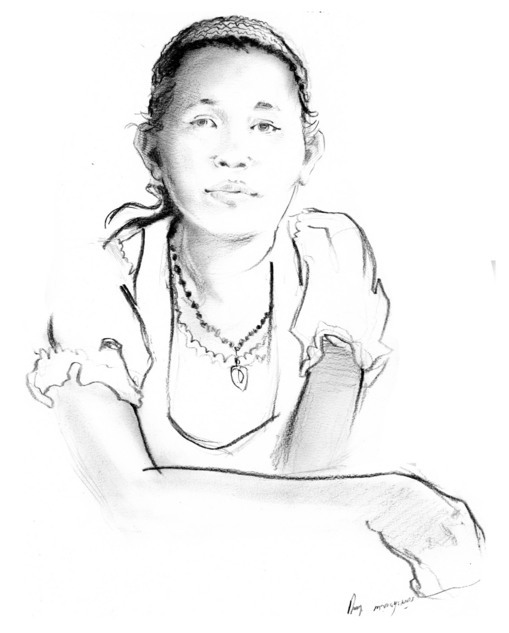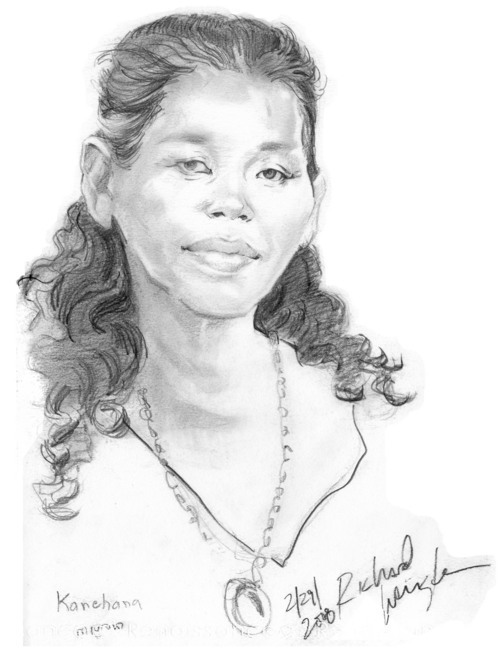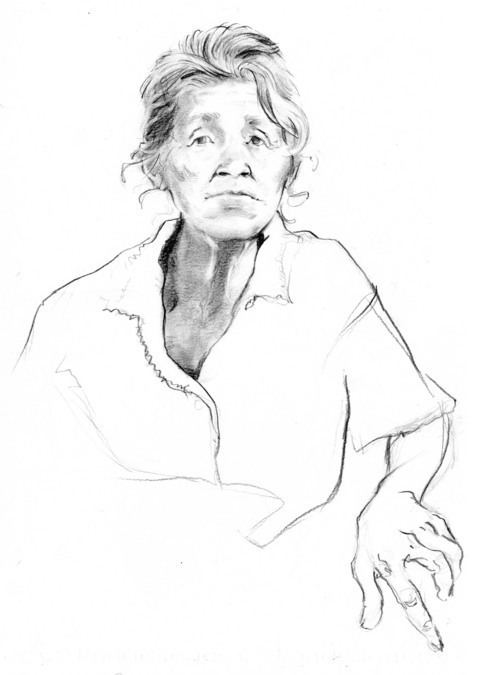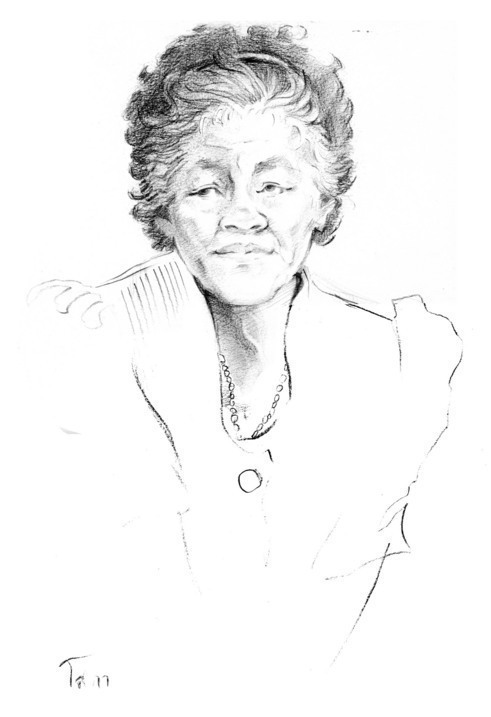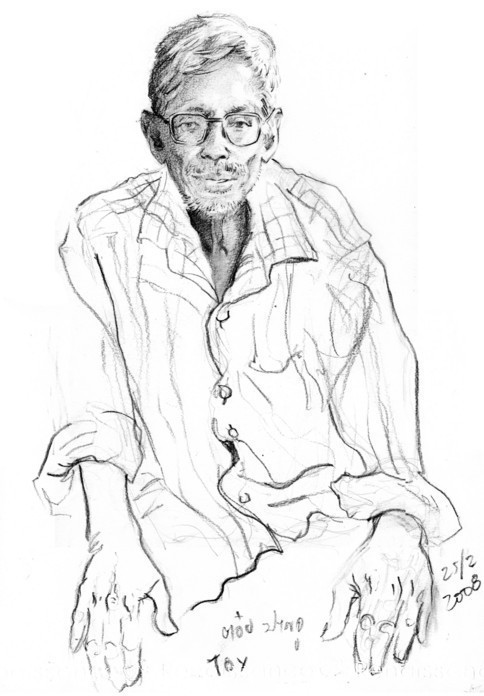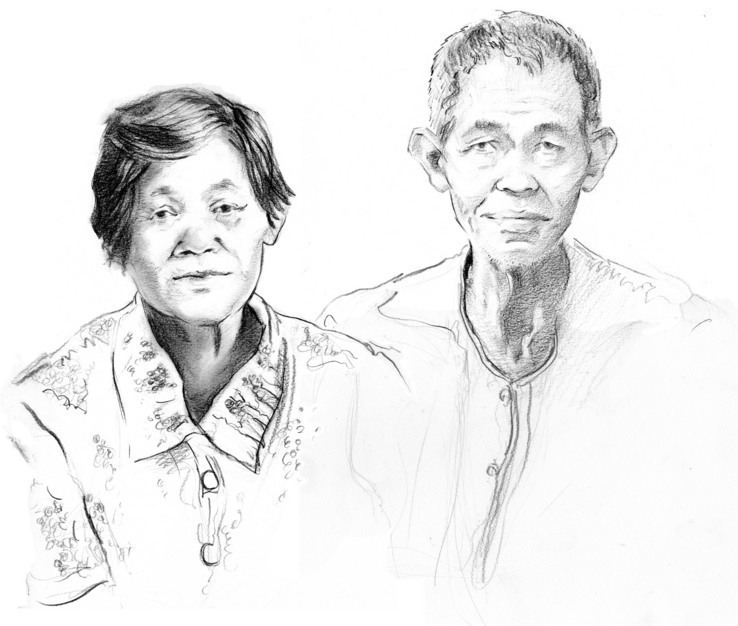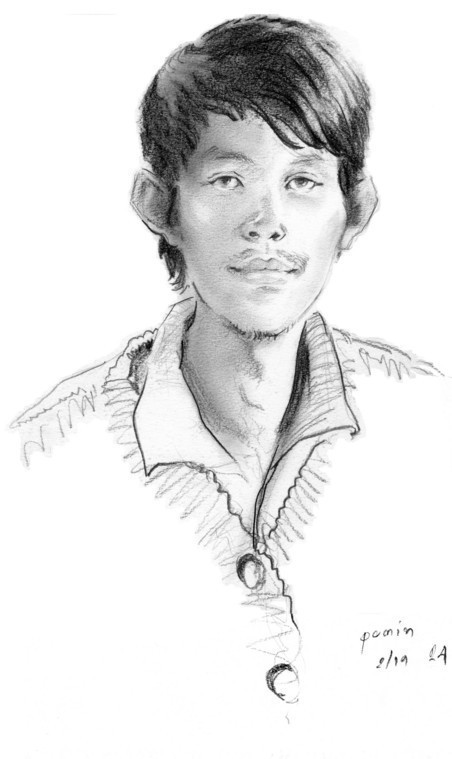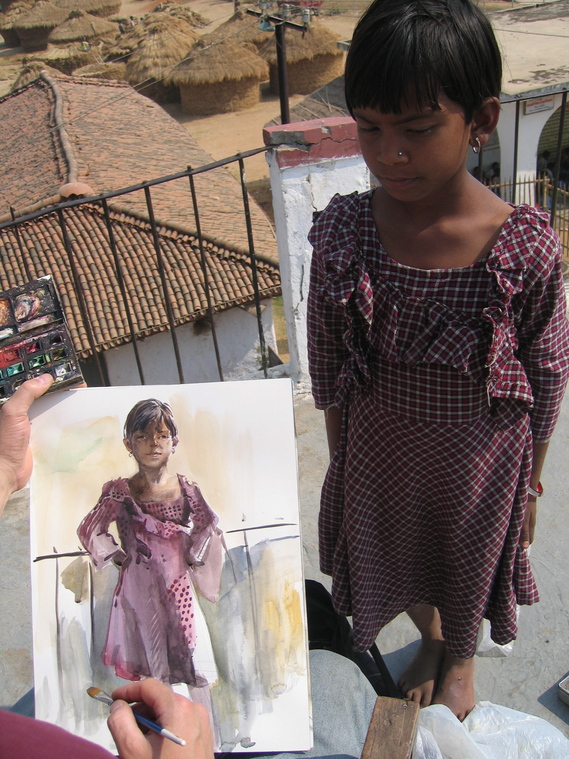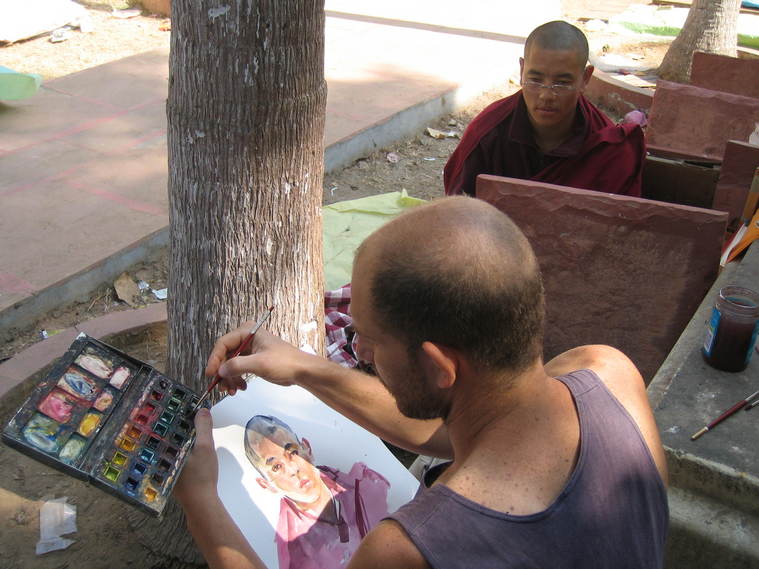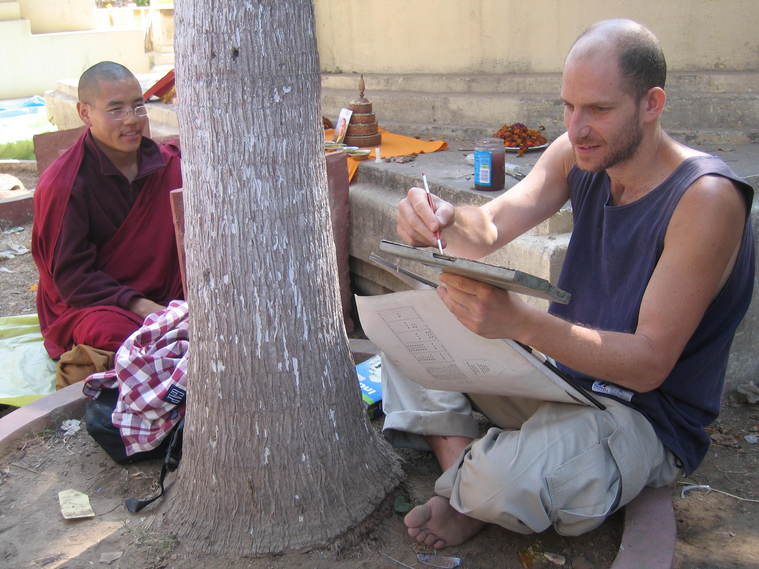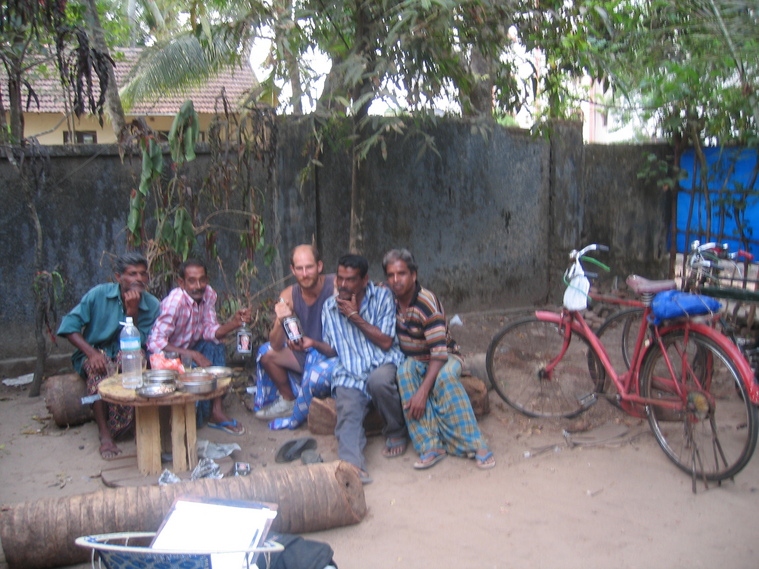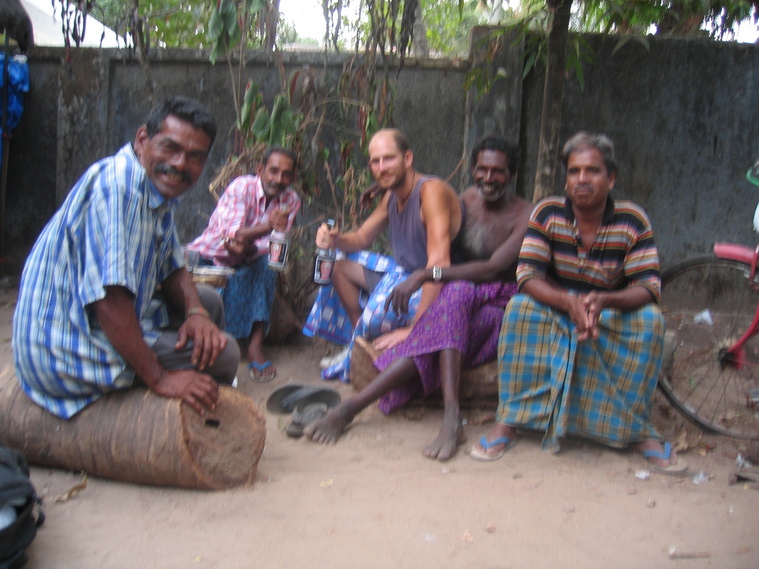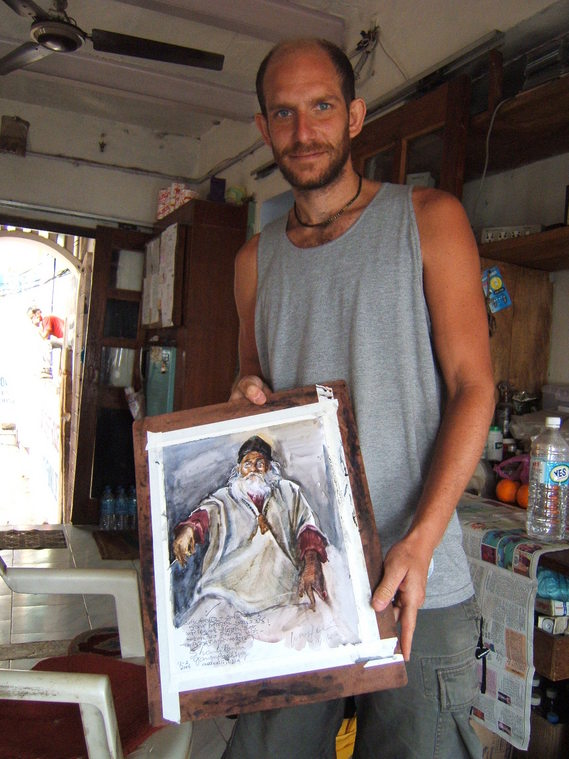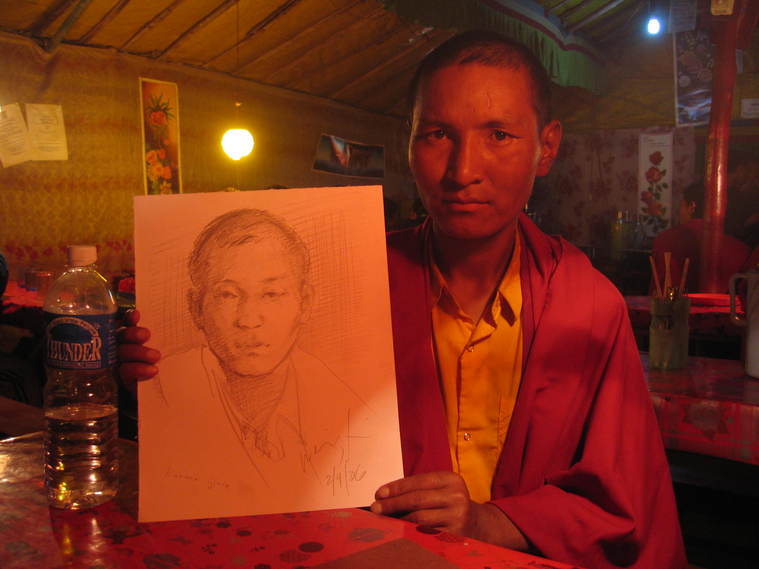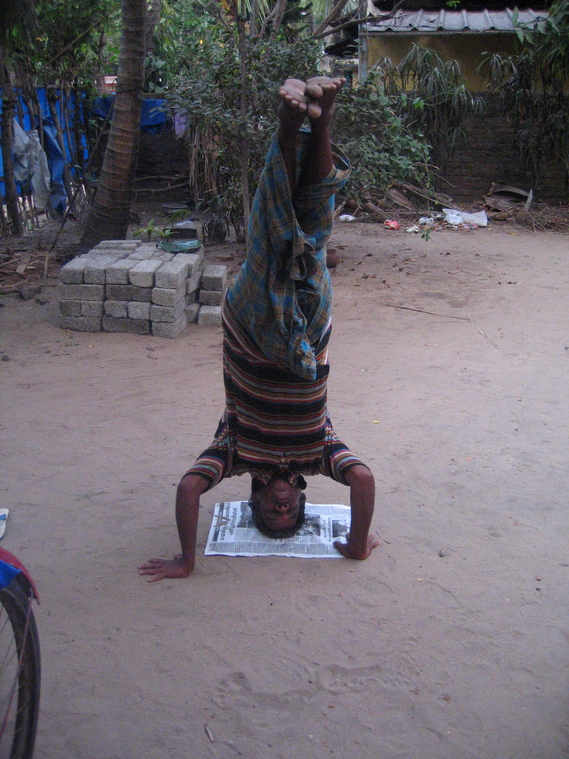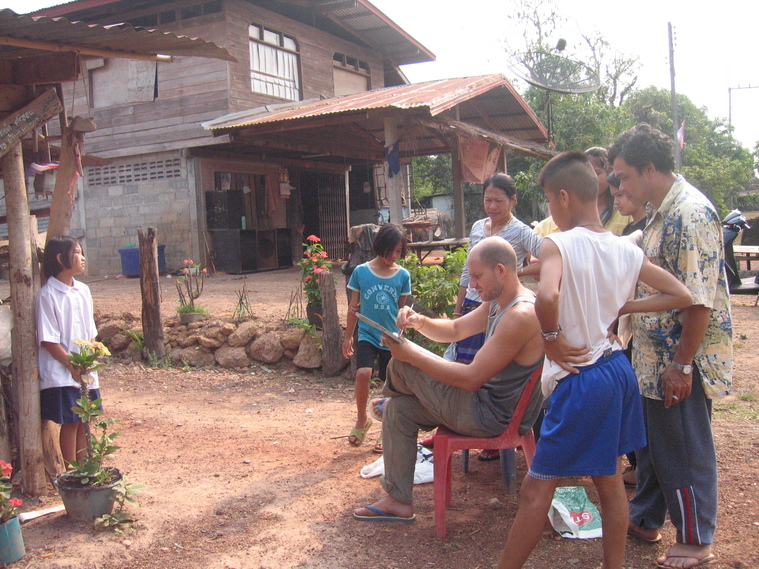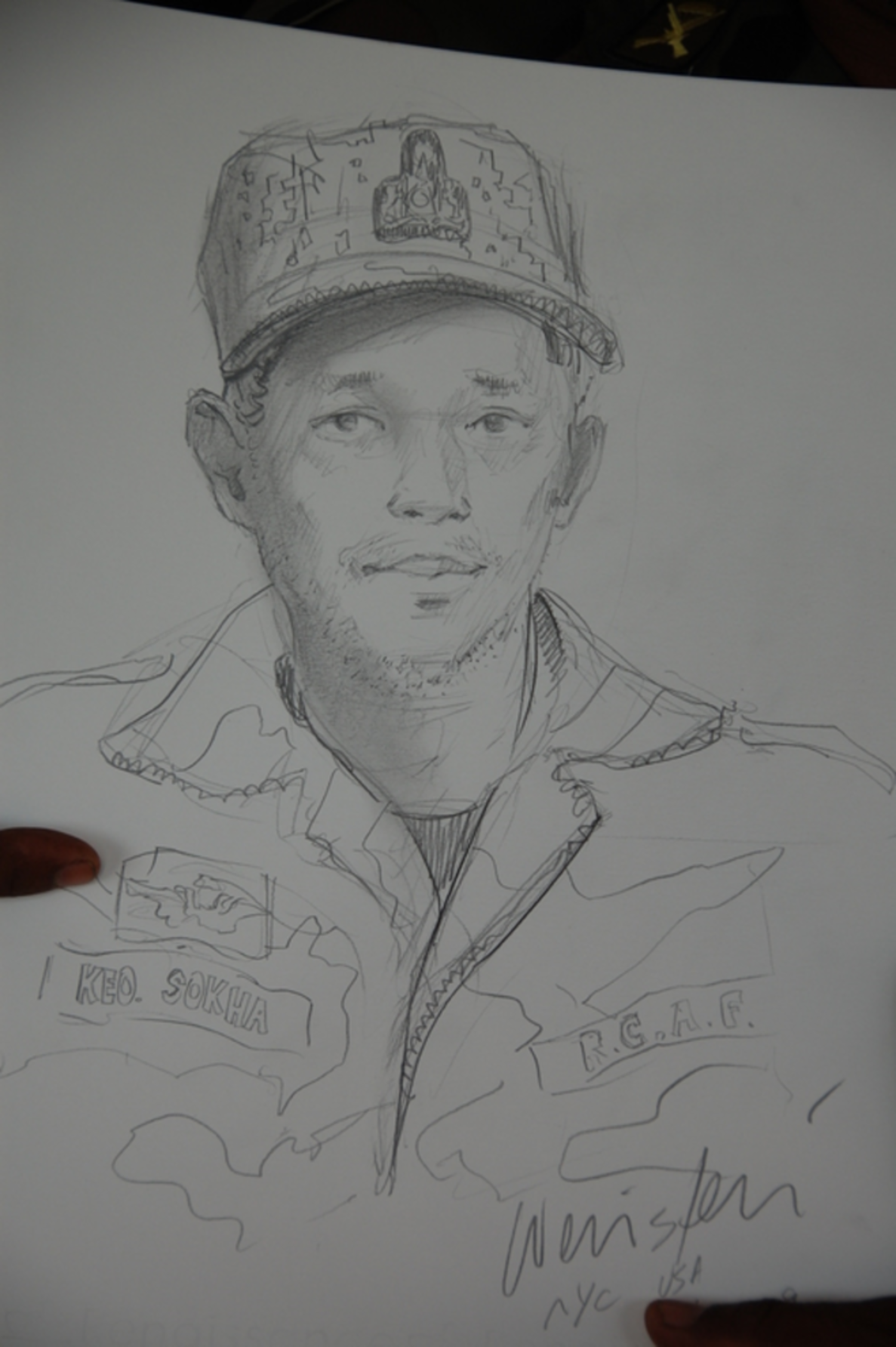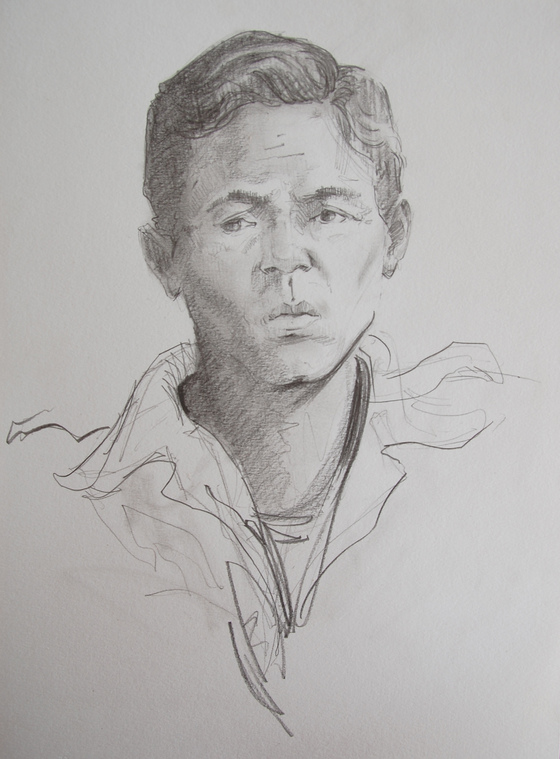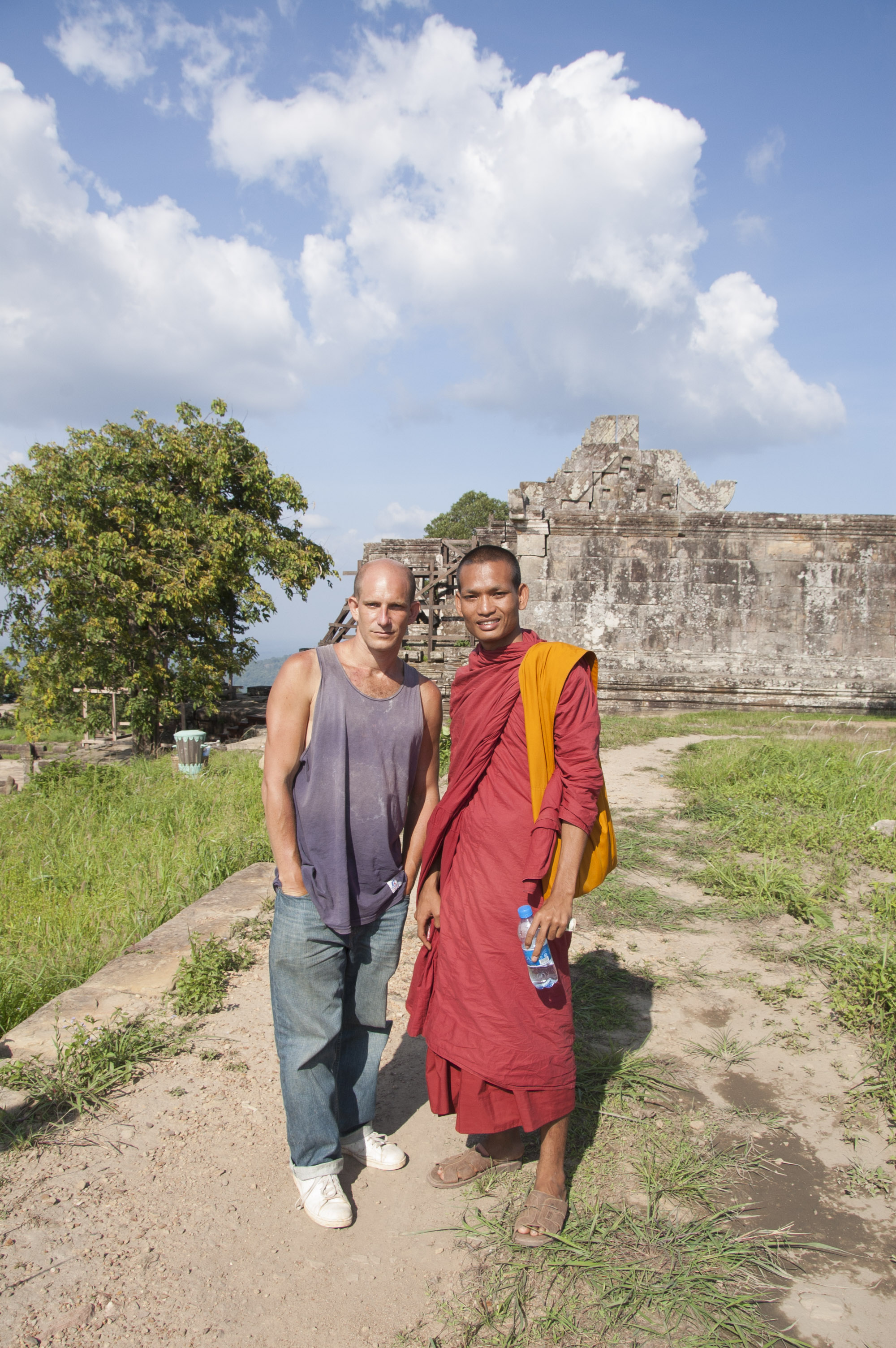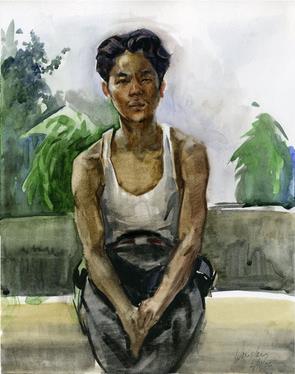
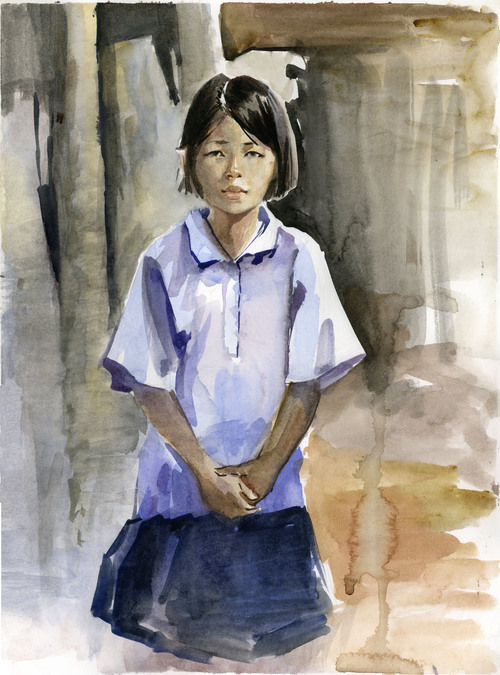
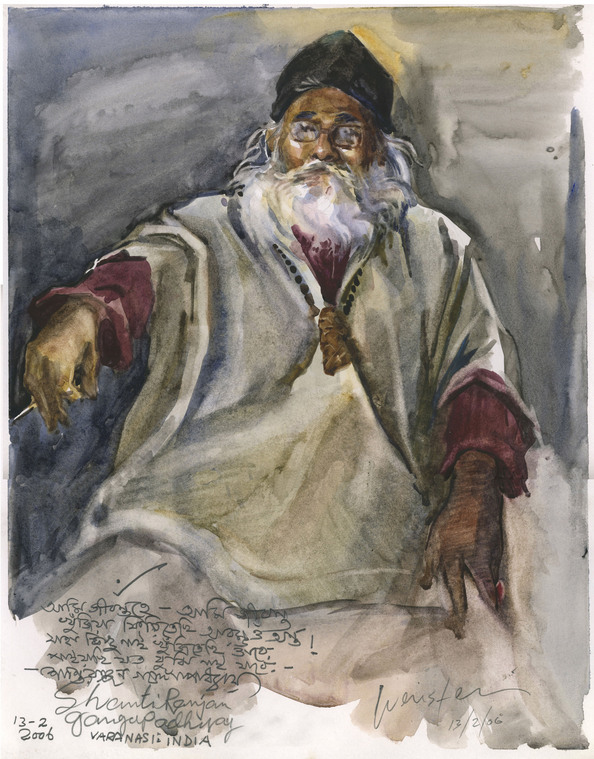
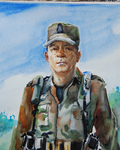
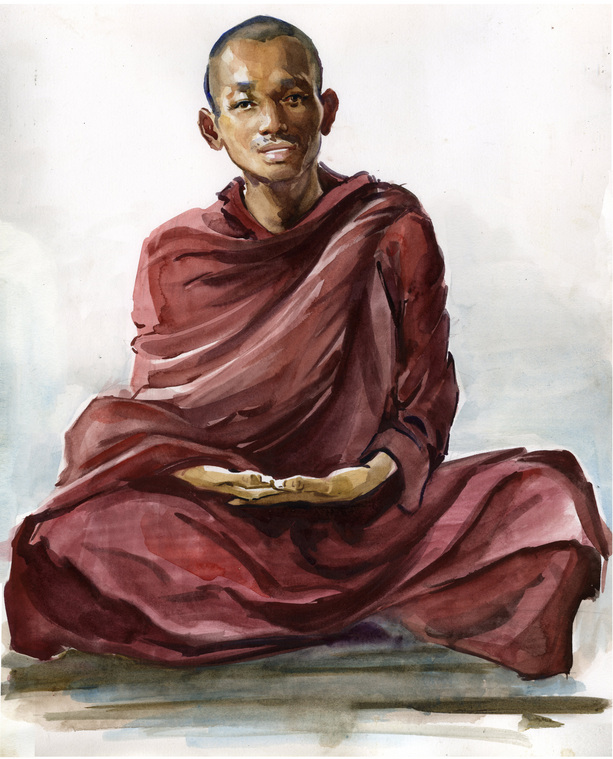
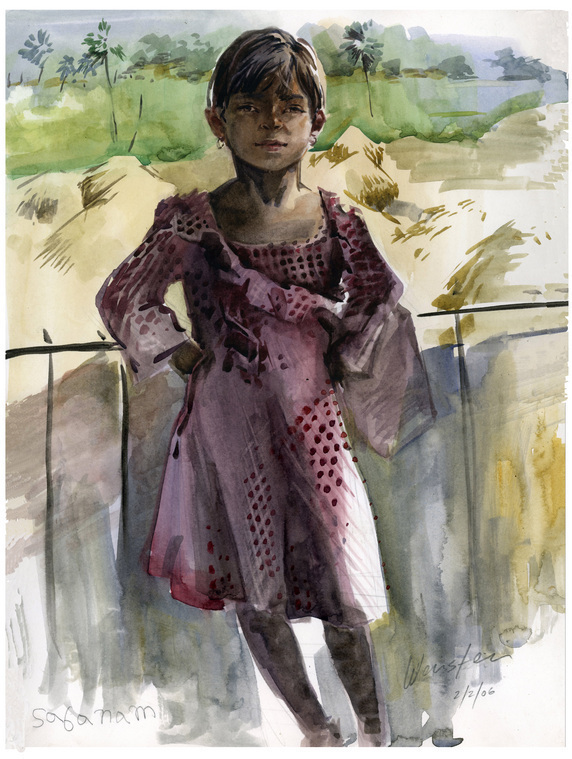
SABANAM
Watercolor, 12" x 16", Bodhgaya
One afternoon in the hustle-bustle of Bodhgaya's markets, a local randomly came up to me inviting meto visit the school he directs. At 7 am the following morning, he and one of his friends came racing through the dust on motorcycles picking me up at my guesthouse, and we sped off across town eventually crossing the border of a dry riverbed that separated 2 very, very different communities…. Disappearing into the brush of palm trees and shacks, I lost sight of everything I knew before and was now in the hands and security of complete strangers, including a few new cycles and rider-friends that suddenly surrounded us and escorted us to the door of an unnamed, unmarked, ramshackle of a building. We stopped, I was rushed inside without any word nor without any room to escape, hurried up 4 flights of unlit stairs, shown where my free room would be if I decided to stay, then rushed up to the roof. Staring at me were another 5 or 6 adult male faces. Overwhelmed by the 12 people now encircling me, it was time to seriously figure out how I was going to get away should anybody try anything, when they escorted me to a palm-leaf hut on the roof's edge where 25 smiling children all looked up from their school books and sang out "Namaste"…….
Asked to teach them all an art lesson, one of the adults translated everything as I paired them all up and had them work together, drawing each other's portraits using very basic measurements. Before long, the morning turned into my drawing one-minute crayon portraits of everybody there, including the adults.
Afterwards, when all the children were supposed to be dismissed for the day, I was given another tour of the building, shown my possible room again, and introduced to the woman who would cook all my feels for free, if I did decide to stay. Following us around the wholetime was one of the girls from class. I asked why her parents hadn't come toget her yet when I was told she has none, she lives at the school, as do about one third of the other kids. As it was, the school also doubled as an orphanage.
I asked my host if I could paint her portrait, and he quickly agreed. Up on the roof it was peak afternoon heat, over 110+ degrees, but there we sat and worked while underneath us on the dirt roads below I could see open-air private schools still in session as well as all the other village children playing sports. After we finished, my host explained the mission of his school— it was created specifically for orphans and the less fortunate-- and I asked specifically about her. I was told they found her begging in the streets, abandoned by her parents, and that she's getting close to the age where she should be arranged for marriage as the school was taking on the responsibility of finding her a suitable husband. I asked her age, but since she didn't know, neither did the school. But she was very, very proud that she could write her name… Sabanam.
As my host was driving me on his cycle back out of the brush and across the riverbed, back into Bodhgaya, I was speechless thinking about if there was anything I could possibly do……
Watercolor, 12" x 16", Bodhgaya
One afternoon in the hustle-bustle of Bodhgaya's markets, a local randomly came up to me inviting meto visit the school he directs. At 7 am the following morning, he and one of his friends came racing through the dust on motorcycles picking me up at my guesthouse, and we sped off across town eventually crossing the border of a dry riverbed that separated 2 very, very different communities…. Disappearing into the brush of palm trees and shacks, I lost sight of everything I knew before and was now in the hands and security of complete strangers, including a few new cycles and rider-friends that suddenly surrounded us and escorted us to the door of an unnamed, unmarked, ramshackle of a building. We stopped, I was rushed inside without any word nor without any room to escape, hurried up 4 flights of unlit stairs, shown where my free room would be if I decided to stay, then rushed up to the roof. Staring at me were another 5 or 6 adult male faces. Overwhelmed by the 12 people now encircling me, it was time to seriously figure out how I was going to get away should anybody try anything, when they escorted me to a palm-leaf hut on the roof's edge where 25 smiling children all looked up from their school books and sang out "Namaste"…….
Asked to teach them all an art lesson, one of the adults translated everything as I paired them all up and had them work together, drawing each other's portraits using very basic measurements. Before long, the morning turned into my drawing one-minute crayon portraits of everybody there, including the adults.
Afterwards, when all the children were supposed to be dismissed for the day, I was given another tour of the building, shown my possible room again, and introduced to the woman who would cook all my feels for free, if I did decide to stay. Following us around the wholetime was one of the girls from class. I asked why her parents hadn't come toget her yet when I was told she has none, she lives at the school, as do about one third of the other kids. As it was, the school also doubled as an orphanage.
I asked my host if I could paint her portrait, and he quickly agreed. Up on the roof it was peak afternoon heat, over 110+ degrees, but there we sat and worked while underneath us on the dirt roads below I could see open-air private schools still in session as well as all the other village children playing sports. After we finished, my host explained the mission of his school— it was created specifically for orphans and the less fortunate-- and I asked specifically about her. I was told they found her begging in the streets, abandoned by her parents, and that she's getting close to the age where she should be arranged for marriage as the school was taking on the responsibility of finding her a suitable husband. I asked her age, but since she didn't know, neither did the school. But she was very, very proud that she could write her name… Sabanam.
As my host was driving me on his cycle back out of the brush and across the riverbed, back into Bodhgaya, I was speechless thinking about if there was anything I could possibly do……
ANIL, WAITER, 30 YEARS OLD
Watercolor, 10" x 14", Bodhgaya
One of many Tibetan refugees that live in Bodhgaya, we got to know each other over a few meals of Thupka and momos (noodle soup and dumplings). While I was eating, he explained how his family was still back in Tibet, and there's no way he could ever get back to them without getting arrested. He told me of the love triangle between him, his boss, and the waitress between them. And he told me how his broken-heart story eventually led to getting fired from the restaurant. He showed me where I could replenish my supplies when they were in severe danger of running out in the truest middle of Nowhere! He took me to the rooftops of Hindu altars at a burial ground no longer used and that had become overgrown with trees, inviting me to smoke marijuana and hashish with him and some Buddhist monks up there while looking out over the town, temples, and prayergrounds. Instead, I just sketched up there along side them, baking for 6 hours under the most intense 110+ degree heat of peak-afternoon sun….
Watercolor, 10" x 14", Bodhgaya
One of many Tibetan refugees that live in Bodhgaya, we got to know each other over a few meals of Thupka and momos (noodle soup and dumplings). While I was eating, he explained how his family was still back in Tibet, and there's no way he could ever get back to them without getting arrested. He told me of the love triangle between him, his boss, and the waitress between them. And he told me how his broken-heart story eventually led to getting fired from the restaurant. He showed me where I could replenish my supplies when they were in severe danger of running out in the truest middle of Nowhere! He took me to the rooftops of Hindu altars at a burial ground no longer used and that had become overgrown with trees, inviting me to smoke marijuana and hashish with him and some Buddhist monks up there while looking out over the town, temples, and prayergrounds. Instead, I just sketched up there along side them, baking for 6 hours under the most intense 110+ degree heat of peak-afternoon sun….
TASHI, 26 YEARS OLD
Watercolor, 12" x 16", Bodhgaya
Thousands of monks and pilgrims from all around the world visit Bodhgaya every year and every day to pray at the huge Mahabodhi Temple, built at the site of the original Bodhi tree that Siddhartha Guatanama—the founder of Buddhism-- found enlightenment under. For 12 hours a day the monks surround everything, creating a sea of crimson and saffron robes, then pray and chant, break, then pray and chant again, up until early evening. Intoxicatingly fragrant marigold garlands and candles decorate everything, unison "OM" and mantras are heard everywhere, and the spiritual uplifting is unimaginable.....!
While sitting with them for hours and days under the tree and watching the faces ofthe world go by— Buddhists from Australia, Europe, America, Bhutan, Tibet, China, Japan, Thailand, Vietnam, Sri Lanka, Indonesia, Korea, and almost everywhere else in the world-- and while the falling leaves brought good luck to all those that could catch them, many of the monks took an interest in my sketching, asking if I would do quick pencil sketch portraits of them. With Tashi, one of the senior monks from Tibet, we agreed to an exchange: meet after the afternoon prayer sessions at his altar, where Icould paint one for him and one for me.
Watercolor, 12" x 16", Bodhgaya
Thousands of monks and pilgrims from all around the world visit Bodhgaya every year and every day to pray at the huge Mahabodhi Temple, built at the site of the original Bodhi tree that Siddhartha Guatanama—the founder of Buddhism-- found enlightenment under. For 12 hours a day the monks surround everything, creating a sea of crimson and saffron robes, then pray and chant, break, then pray and chant again, up until early evening. Intoxicatingly fragrant marigold garlands and candles decorate everything, unison "OM" and mantras are heard everywhere, and the spiritual uplifting is unimaginable.....!
While sitting with them for hours and days under the tree and watching the faces ofthe world go by— Buddhists from Australia, Europe, America, Bhutan, Tibet, China, Japan, Thailand, Vietnam, Sri Lanka, Indonesia, Korea, and almost everywhere else in the world-- and while the falling leaves brought good luck to all those that could catch them, many of the monks took an interest in my sketching, asking if I would do quick pencil sketch portraits of them. With Tashi, one of the senior monks from Tibet, we agreed to an exchange: meet after the afternoon prayer sessions at his altar, where Icould paint one for him and one for me.
RAKAS
A.K.A. "FUTURE THINKER"
Watercolor, 10" x 14", Varanasi
Varanasi is lined with ghats (sets of steps and landings) that lead to the Ganges River. The most fascinating ones bustle with enormous amounts and variety of color and life--full of flower and jewelry sellers, performers, barbers, people washing and slapping their laundry on the rocks, swimmers, bathers, and whole families of dogs, cows, oxen, and goats that would all wander together…. The shadow side to all this lively activity is all the mystery and intrigue of Death nearby.
As one of the holiest cities for Hindus to be in when they die, people come from miles around or spend days traveling just to be here when the time is near…. Immediately afterwards— without any waiting period like in the West— the funeral takes place, as quickly as they can bring the body. This could be 1 hour later, 3 hours later, or however long it takes. There are two funeral ghats specifically intended for the holy ritual of quickly bathing the body, then cremating it, the larger ghat being known as "Manikarnika."
The morning that I first explored Manikarnika, I sat down in what I thought was just another pile of dirt by the steps, anxious to sketch from a dramatic perspective that was up close. Not much was going on, and only a few fires were going. A child dressed in white robes with a shaved head sat down on some rocks just higher than me, took an interest in what I was doing, then shouted for attention. Despite a language barrier, he asked for his portrait to be sketched so we worked out an exchange of one for one.
During our process, the amount of bodies coming down started to pick up, the smoke started to thicken until I was choking on it, and I realized there was no dirt at all around me. I was sitting on piles and piles and piles of human ashes, breathing in the ash and soot, and becoming covered with ash. Still, we kept working despite numerous obstacles, including a mayhem of people trying to forcibly separate us, until eventually, there were so many pyres constructed around us along with bodies ready to be cremated that we were now in the way…. Quickly finishing, he was then escorted away, and as he disappeared I asked him his name. "Rakas" he shouted back.
As I was packing up, some of the men standing around watching us explained what was happening. Rakas's father was the deceased and he was about to perform the holy rite of cremating him, as the next of kin. Rakas was only 10 years old.
A.K.A. "FUTURE THINKER"
Watercolor, 10" x 14", Varanasi
Varanasi is lined with ghats (sets of steps and landings) that lead to the Ganges River. The most fascinating ones bustle with enormous amounts and variety of color and life--full of flower and jewelry sellers, performers, barbers, people washing and slapping their laundry on the rocks, swimmers, bathers, and whole families of dogs, cows, oxen, and goats that would all wander together…. The shadow side to all this lively activity is all the mystery and intrigue of Death nearby.
As one of the holiest cities for Hindus to be in when they die, people come from miles around or spend days traveling just to be here when the time is near…. Immediately afterwards— without any waiting period like in the West— the funeral takes place, as quickly as they can bring the body. This could be 1 hour later, 3 hours later, or however long it takes. There are two funeral ghats specifically intended for the holy ritual of quickly bathing the body, then cremating it, the larger ghat being known as "Manikarnika."
The morning that I first explored Manikarnika, I sat down in what I thought was just another pile of dirt by the steps, anxious to sketch from a dramatic perspective that was up close. Not much was going on, and only a few fires were going. A child dressed in white robes with a shaved head sat down on some rocks just higher than me, took an interest in what I was doing, then shouted for attention. Despite a language barrier, he asked for his portrait to be sketched so we worked out an exchange of one for one.
During our process, the amount of bodies coming down started to pick up, the smoke started to thicken until I was choking on it, and I realized there was no dirt at all around me. I was sitting on piles and piles and piles of human ashes, breathing in the ash and soot, and becoming covered with ash. Still, we kept working despite numerous obstacles, including a mayhem of people trying to forcibly separate us, until eventually, there were so many pyres constructed around us along with bodies ready to be cremated that we were now in the way…. Quickly finishing, he was then escorted away, and as he disappeared I asked him his name. "Rakas" he shouted back.
As I was packing up, some of the men standing around watching us explained what was happening. Rakas's father was the deceased and he was about to perform the holy rite of cremating him, as the next of kin. Rakas was only 10 years old.
SHANTI
Watercolor, 10" x 14", Varanasi
A loud and energetic Bengali poet that's never seen without his Rabindranath Tagore amulet around his neck, Shanti lived in Tokyo throughout the 50's and 60's as a visiting scholar at one of the universities, published volumes of poetry, and had many gallery shows of his paintings. During this time he met his wife-to-be, Kumiko, but he always followed events back in his native land.
The 1970's and 80's turned into a violent period for some travelers to India, particularly in the mysterious, almost medieval-like, cavernous, stone alleyways of Varanasi. Travelers often were reported missing or found murdered, some even killed just for their body parts. Greatly disturbed by this, Shanti intended to open a safe haven for the Japanese travelers only. Relocating his new family to Varanasi, he and Kumiko opened a guesthouse on the bank of the Ganges calling it "Kumiko's House," and offered free room and board until eventually the government took notice and ordered him to charge a nominal fee, if he intended to stay in business. They've now been there over two decades.
Now, Shanti's days are often spent sitting by his window in the living room, still writing, reading, and watching the morning pink sun rise and become pale yellow over the Ganges, and rattling, ranting, and raving on in Hindi, Japanese, or English as a genius-madman poet full of stories and pictures from his past. Allthroughout, he'll interrupt himself to yell cautionary instructions at every traveler coming and going, as if we're his children that he wants to protect.
Once Shanti started seeing me come home (he was gracious enough to allow me to stay at his guesthouse as the only Westerner) with sketches under my arm, he asked me to sit with him by his throne at the window. Showing him the portraits I had done, he was inspired to create names for them immediately. He called the deadwoman: "Cosmic Traveler," the dead baby: "Who is Going on a Cosmic Journey…." and Rakas: "Future Thinker." He then asked me to paint his portrait as well.
Days later, with his huge robe, sandals, amulet, and an enormous walking stick, Shanti then took me on a tour across town seeking out the only color copier anywhere… and after waiting out the daily power outage that could have taken forever, he brought me to his friend's one-room apartment in the middle of some dung fields— where beautifully dressed women in colorful saris would turn fresh cow dung into patties so they can bake, dry out, and eventually be turned into fuel— and there we sat drinking chai for hours while discussing politics, art, and the world at large....
Watercolor, 10" x 14", Varanasi
A loud and energetic Bengali poet that's never seen without his Rabindranath Tagore amulet around his neck, Shanti lived in Tokyo throughout the 50's and 60's as a visiting scholar at one of the universities, published volumes of poetry, and had many gallery shows of his paintings. During this time he met his wife-to-be, Kumiko, but he always followed events back in his native land.
The 1970's and 80's turned into a violent period for some travelers to India, particularly in the mysterious, almost medieval-like, cavernous, stone alleyways of Varanasi. Travelers often were reported missing or found murdered, some even killed just for their body parts. Greatly disturbed by this, Shanti intended to open a safe haven for the Japanese travelers only. Relocating his new family to Varanasi, he and Kumiko opened a guesthouse on the bank of the Ganges calling it "Kumiko's House," and offered free room and board until eventually the government took notice and ordered him to charge a nominal fee, if he intended to stay in business. They've now been there over two decades.
Now, Shanti's days are often spent sitting by his window in the living room, still writing, reading, and watching the morning pink sun rise and become pale yellow over the Ganges, and rattling, ranting, and raving on in Hindi, Japanese, or English as a genius-madman poet full of stories and pictures from his past. Allthroughout, he'll interrupt himself to yell cautionary instructions at every traveler coming and going, as if we're his children that he wants to protect.
Once Shanti started seeing me come home (he was gracious enough to allow me to stay at his guesthouse as the only Westerner) with sketches under my arm, he asked me to sit with him by his throne at the window. Showing him the portraits I had done, he was inspired to create names for them immediately. He called the deadwoman: "Cosmic Traveler," the dead baby: "Who is Going on a Cosmic Journey…." and Rakas: "Future Thinker." He then asked me to paint his portrait as well.
Days later, with his huge robe, sandals, amulet, and an enormous walking stick, Shanti then took me on a tour across town seeking out the only color copier anywhere… and after waiting out the daily power outage that could have taken forever, he brought me to his friend's one-room apartment in the middle of some dung fields— where beautifully dressed women in colorful saris would turn fresh cow dung into patties so they can bake, dry out, and eventually be turned into fuel— and there we sat drinking chai for hours while discussing politics, art, and the world at large....
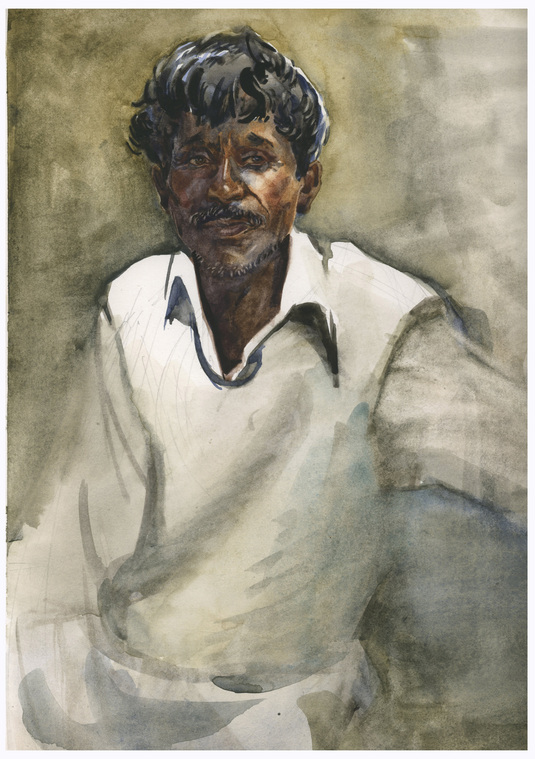
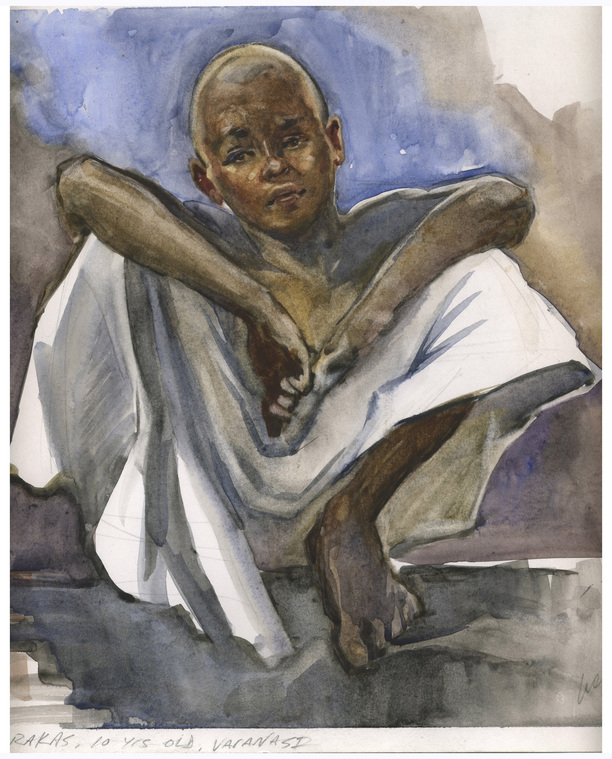
LALO
Watercolor, 10" x 14", Varanasi
The Varanasi stretch of the Ganges River is filled with bodies— below and above the water, and Lalo is one of the scores of ferrymen who regularly would row up and down, giving tours. Always stationing himself by Manikarnika to wait for passengers, he came to know me after watching me sketch over a few days. Unable to speak in any English whatsoever, we still found ways to understand each other, and he helped to negotiate the deal to paint the dead baby. He would also give me rides for free, always claiming that his boat was my boat, and he encouraged me to photograph everything that was normally forbidden. This particular morning, he wasn't dressed the way I was used to seeing him— in a tattered white t-shirt and lungi (an apron), instead he was dressed looking like a polo player! Taking me out offshore to sit and sketch undisturbed by all the locals who had come to know me, he still asked for nothing and was willing to sit for me himself…
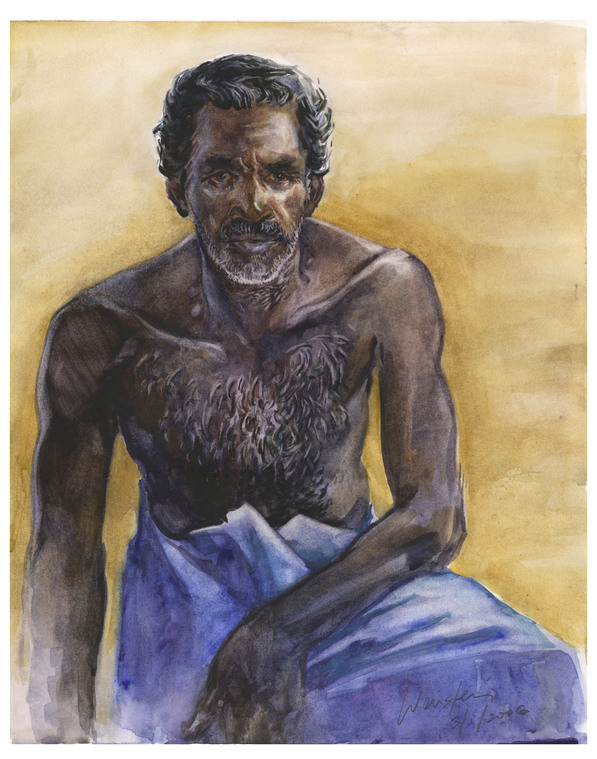
LALO, THE FISHERMAN
Watercolor, 10" x 14", Fort Cochin, Kerala
A true bohemian hangout where artists, art galleries, and expatriates mix with the fishing industry, Fort Cochin's favorite attractions are the 7 enormous Chinese cantilever-fishing nets that have been working for over 100 years. For 10 hours a day they raise and lower catching schools of small fish while boats launch out and bring back bigger catches. Then everybody sells their finds to the local fish market kiosks set up along the shore, which then sell everything at retail. The practice is to buy any fish of choice— including the occasional shark— and bring it to any of the "you buy it, we cook it" food stands also set up right there, ready to grill, fry, or steam the fish to order.
As I was out sketching the nets one day, observing the 5-man teams pulling down the ropes of massive boulder counter-weights, one group of local fishermen took an interest in me and kept bringing me chai and samosas every time they took a break as well. By the day's end, they had invited me to sit with them even though none of them spoke any English and I didn't speak the local dialect—Malayalam-- either. But it didn't matter. We were all friends.
Their leader was 6'5", built semi-truck-like, and with so much hair on his body that he looked like a bird's nest! His mustache was like barbed wire, his jaw looked like it could crack rocks, his legs were like hydraulic pumps, and his bony hands looked like they've ripped apart elephants. His 2nd man was humble and reserved, much shorter at about 5'7," and even hairier and greyer than the leader-- looking almost like an ice age mammoth-- and packed with so much lean, chiseled muscle that every inch of him was angled, squared, and cubed. Guy #3 was about 5'8" with fierce beady eyes and a wiry, spindly neck that fed into his triangular, flat-topped head, and his weathered chin was shaped like a cutting stone. His mustache was thick, his stubble like glass shards, and his grin was a mile wide! Guy #4 had a round, chubby face, and bear-like frame that was all mass and power, with practically no hardening of his skin. The 5th guy looked the youngest at maybe 36, was the roundest of them all, and would wobble around with excitement, enthusiasm, and curiosity like Winnie-the-Pooh.
Immediately, Lalo started pouring full glasses of straight rum for all of us-- practically triple-shots— that we'd swig before slamming our glasses down signaling the readiness for each following round! All this was accompanied by overflowing plates of barbecued, dry spiced fish and spicy stuffed baby crabs as the sun fell lower and lower, the blues got deeper turning to purple, and the clouds became an intense neon-glowing salmon before disappearing. All night we kept eating and drinking as they all took turns pouring and pouring.
Trying to be a man among men, these REAL men, hulking Hemmingwayesque- heroic men, I did all I could to keep up with them but think I served more as their comic relief as it took all my strength in the world to stay upright and not lose everything in front of them....!
Watercolor, 10" x 14", Fort Cochin, Kerala
A true bohemian hangout where artists, art galleries, and expatriates mix with the fishing industry, Fort Cochin's favorite attractions are the 7 enormous Chinese cantilever-fishing nets that have been working for over 100 years. For 10 hours a day they raise and lower catching schools of small fish while boats launch out and bring back bigger catches. Then everybody sells their finds to the local fish market kiosks set up along the shore, which then sell everything at retail. The practice is to buy any fish of choice— including the occasional shark— and bring it to any of the "you buy it, we cook it" food stands also set up right there, ready to grill, fry, or steam the fish to order.
As I was out sketching the nets one day, observing the 5-man teams pulling down the ropes of massive boulder counter-weights, one group of local fishermen took an interest in me and kept bringing me chai and samosas every time they took a break as well. By the day's end, they had invited me to sit with them even though none of them spoke any English and I didn't speak the local dialect—Malayalam-- either. But it didn't matter. We were all friends.
Their leader was 6'5", built semi-truck-like, and with so much hair on his body that he looked like a bird's nest! His mustache was like barbed wire, his jaw looked like it could crack rocks, his legs were like hydraulic pumps, and his bony hands looked like they've ripped apart elephants. His 2nd man was humble and reserved, much shorter at about 5'7," and even hairier and greyer than the leader-- looking almost like an ice age mammoth-- and packed with so much lean, chiseled muscle that every inch of him was angled, squared, and cubed. Guy #3 was about 5'8" with fierce beady eyes and a wiry, spindly neck that fed into his triangular, flat-topped head, and his weathered chin was shaped like a cutting stone. His mustache was thick, his stubble like glass shards, and his grin was a mile wide! Guy #4 had a round, chubby face, and bear-like frame that was all mass and power, with practically no hardening of his skin. The 5th guy looked the youngest at maybe 36, was the roundest of them all, and would wobble around with excitement, enthusiasm, and curiosity like Winnie-the-Pooh.
Immediately, Lalo started pouring full glasses of straight rum for all of us-- practically triple-shots— that we'd swig before slamming our glasses down signaling the readiness for each following round! All this was accompanied by overflowing plates of barbecued, dry spiced fish and spicy stuffed baby crabs as the sun fell lower and lower, the blues got deeper turning to purple, and the clouds became an intense neon-glowing salmon before disappearing. All night we kept eating and drinking as they all took turns pouring and pouring.
Trying to be a man among men, these REAL men, hulking Hemmingwayesque- heroic men, I did all I could to keep up with them but think I served more as their comic relief as it took all my strength in the world to stay upright and not lose everything in front of them....!
RICKSHAW-WALLAH Watercolor, 12" x 16", Calcutta
He had seen me sketching portraits around the neighborhood over several days-- mostly of the local kids that I would then give the drawings to… He also knew I had been paying an extremely generous sum of rupees to some others. On a Sunday morning, when there's practically no business for these drivers since hardly anybody goes anywhere, he approached me at my usual breakfast spot and asked if he could do a sitting as well. Looking at the sadness in his eyes, there's no way I could have refused…..
He had seen me sketching portraits around the neighborhood over several days-- mostly of the local kids that I would then give the drawings to… He also knew I had been paying an extremely generous sum of rupees to some others. On a Sunday morning, when there's practically no business for these drivers since hardly anybody goes anywhere, he approached me at my usual breakfast spot and asked if he could do a sitting as well. Looking at the sadness in his eyes, there's no way I could have refused…..
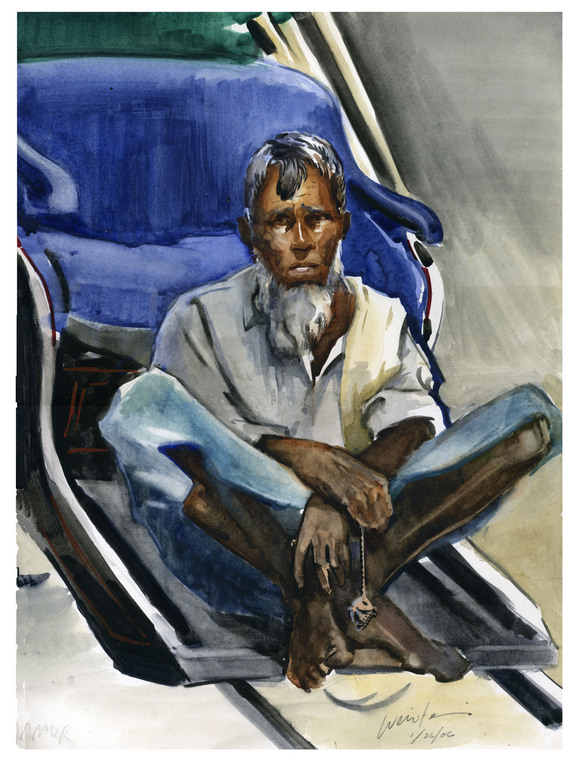
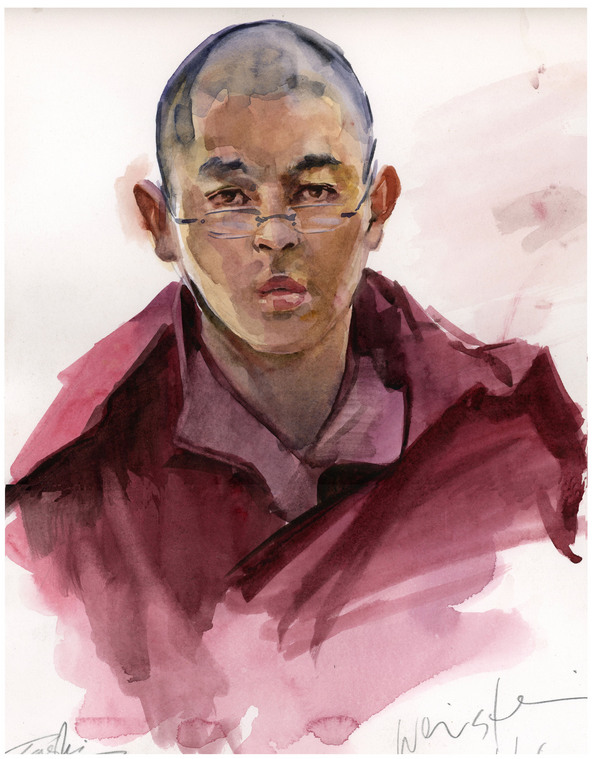
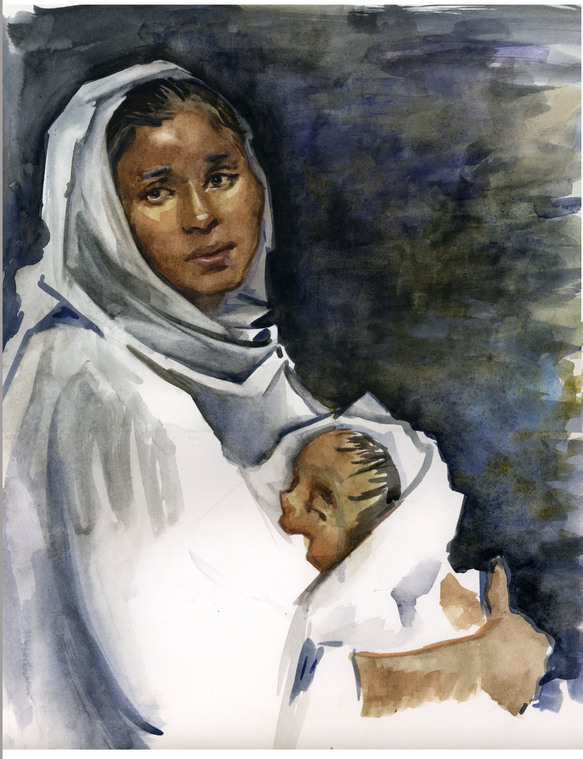
HOMELESS MOTHER
Watercolor, 12" x 16", Calcutta
Very, very early one morning, she came up to me asking for rupees as I was buying breakfast. I asked her to sit for me in exchange, but she didn't understand English and thought I was just another Westerner asking her to be a prostitute. Nobody else was around, so I just sat her down right there on the street and started to sketch. She still didn't understand what was going on, but started to smile when she saw herself on paper and the neighborhood eventually woke up to see her working....
Watercolor, 12" x 16", Calcutta
Very, very early one morning, she came up to me asking for rupees as I was buying breakfast. I asked her to sit for me in exchange, but she didn't understand English and thought I was just another Westerner asking her to be a prostitute. Nobody else was around, so I just sat her down right there on the street and started to sketch. She still didn't understand what was going on, but started to smile when she saw herself on paper and the neighborhood eventually woke up to see her working....
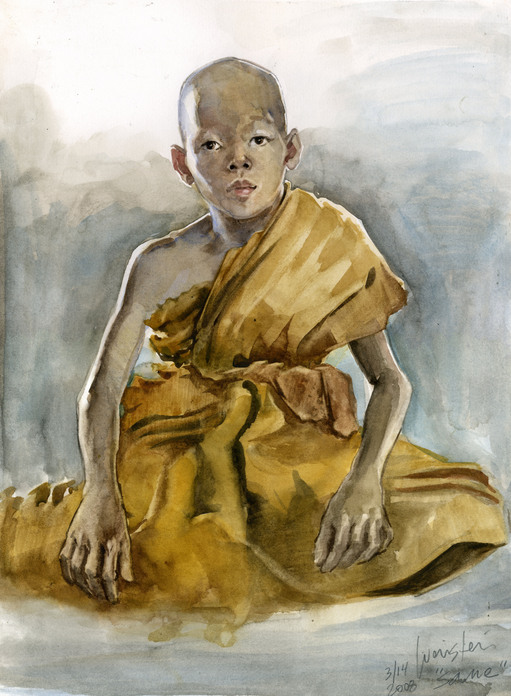
SAME
Watercolor, 11' x 14", Isaan, Thailand
YU-YI
Watercolor, 11" x 14", Isaan, Thailand
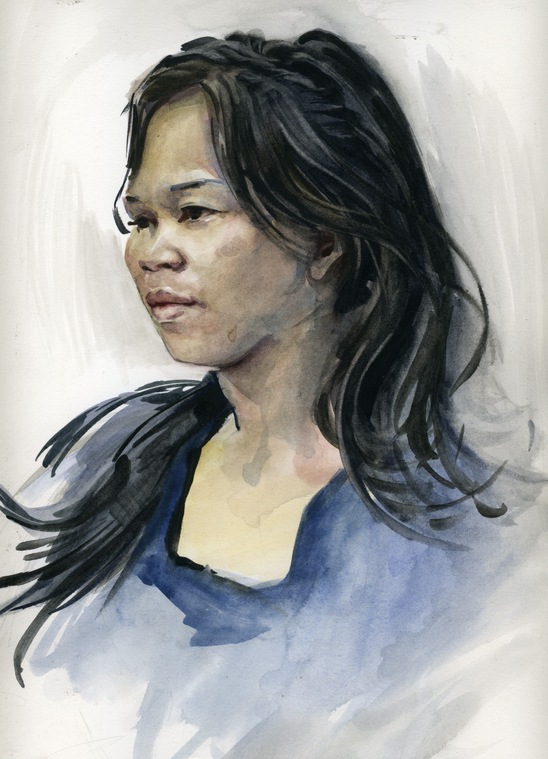
SUKANYA
Watercolor, 12" x 16", Phuket & Isaan, Thailand
GENERAL CHOMM SARAVUTH, detail
Prasat Preah Vihear, Cambodia
SARU YI
watercolor, 12" x 16", Phnom Penh
